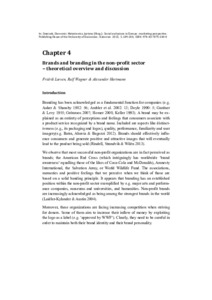Datum
2015Schlagwort
330 Wirtschaft MarkenimageNonprofit-BereichMarketingstrategieNichtstaatliche OrganisationMetadata
Zur Langanzeige
Teil eines Buches

Brands and branding in the non-profit sector − theoretical overview and discussion
Zusammenfassung
Branding has been acknowledged as a fundamental function for companies (e.g. Aaker & Shansby 1982: 56; Ambler et al. 2002: 13; Doyle 1990: 5; Gardner & Levy 1955; Grönroos 2007; Homer 2008; Keller 1993). A brand may be explained as an entirety of perceptions and feelings that consumers associate with a product/service recognized by a brand name. Included are aspects like distinctiveness (e.g., its packaging and logos), quality, performance, familiarity and user imagery (e.g. Batra, Ahuvia & Bagozzi 2012). Brands should effectively influence consumers and generate positive and attractive images that will eventually lead to the product being sold (Rindell, Strandvik & Wilén 2013).
We observe that most successful non-profit organizations are in fact perceived as brands; the American Red Cross (which intriguingly has worldwide ‘brand awareness’ equalling those of the likes of Coca-Cola and McDonalds), Amnesty International, the Salvation Army, or World Wildlife Fund. The associations, memories and positive feelings that we perceive when we think of those are based on a solid banding principle. It appears that branding has an established position within the non-profit sector exemplified by e.g. major arts and performance companies, museums and universities, and humanities. Non-profit brands are increasingly acknowledged as being among the strongest brands in the world (Laidler-Kylander & Austin 2004). Moreover, these organizations are facing increasing competition when striving for donors. Some of them aim to increase their inflow of money by exploiting the logo as a label (e.g. ‘approved by WWF’). Clearly, they need to be careful in order to maintain both their brand identity and their brand personality.
In this study we aim to clarify the conceptual underpinnings of non-profit branding, list the criteria for distinguishing a non-profit brand from ‘conventional’ branding of products and services, relate non-profit branding to organization identity theory.
We observe that most successful non-profit organizations are in fact perceived as brands; the American Red Cross (which intriguingly has worldwide ‘brand awareness’ equalling those of the likes of Coca-Cola and McDonalds), Amnesty International, the Salvation Army, or World Wildlife Fund. The associations, memories and positive feelings that we perceive when we think of those are based on a solid banding principle. It appears that branding has an established position within the non-profit sector exemplified by e.g. major arts and performance companies, museums and universities, and humanities. Non-profit brands are increasingly acknowledged as being among the strongest brands in the world (Laidler-Kylander & Austin 2004). Moreover, these organizations are facing increasing competition when striving for donors. Some of them aim to increase their inflow of money by exploiting the logo as a label (e.g. ‘approved by WWF’). Clearly, they need to be careful in order to maintain both their brand identity and their brand personality.
In this study we aim to clarify the conceptual underpinnings of non-profit branding, list the criteria for distinguishing a non-profit brand from ‘conventional’ branding of products and services, relate non-profit branding to organization identity theory.
Zitierform
In: Smyczek, Sławomir; Matysiewicz, Justyna (Hrsg.): Social exclusions in Europe : marketing perspective. Publishing House of the University of Economics: Katowice 2015, S. 189-200; isbn:978-83-7875-240-0Zitieren
@inbook{doi:10.17170/kobra-202108164562,
author={Larsen, Fridrik and Wagner, Ralf and Hartmann, Alexander},
title={Brands and branding in the non-profit sector − theoretical overview and discussion},
pages={189-200},
publisher={Publishing House of the University of Economics},
year={2015}
}
0500 Oax
0501 Text $btxt$2rdacontent
0502 Computermedien $bc$2rdacarrier
1100 2015$n2015
1500 1/eng
2050 ##0##http://hdl.handle.net/123456789/13143
3000 Larsen, Fridrik
3010 Wagner, Ralf
3010 Hartmann, Alexander
4000 Brands and branding in the non-profit sector − theoretical overview and discussion / Larsen, Fridrik
4030
4060 Online-Ressource
4085 ##0##=u http://nbn-resolving.de/http://hdl.handle.net/123456789/13143=x R
4204 \$dTeil eines Buches
4170
5550 {{Markenimage}}
5550 {{Nonprofit-Bereich}}
5550 {{Marketingstrategie}}
5550 {{Nichtstaatliche Organisation}}
7136 ##0##http://hdl.handle.net/123456789/13143
<resource xsi:schemaLocation="http://datacite.org/schema/kernel-2.2 http://schema.datacite.org/meta/kernel-2.2/metadata.xsd"> 2021-08-20T14:07:35Z 2021-08-20T14:07:35Z 2015 doi:10.17170/kobra-202108164562 http://hdl.handle.net/123456789/13143 eng Publishing House of the University of Economics Urheberrechtlich geschützt https://rightsstatements.org/page/InC/1.0/ 330 Brands and branding in the non-profit sector − theoretical overview and discussion Teil eines Buches Branding has been acknowledged as a fundamental function for companies (e.g. Aaker & Shansby 1982: 56; Ambler et al. 2002: 13; Doyle 1990: 5; Gardner & Levy 1955; Grönroos 2007; Homer 2008; Keller 1993). A brand may be explained as an entirety of perceptions and feelings that consumers associate with a product/service recognized by a brand name. Included are aspects like distinctiveness (e.g., its packaging and logos), quality, performance, familiarity and user imagery (e.g. Batra, Ahuvia & Bagozzi 2012). Brands should effectively influence consumers and generate positive and attractive images that will eventually lead to the product being sold (Rindell, Strandvik & Wilén 2013). We observe that most successful non-profit organizations are in fact perceived as brands; the American Red Cross (which intriguingly has worldwide ‘brand awareness’ equalling those of the likes of Coca-Cola and McDonalds), Amnesty International, the Salvation Army, or World Wildlife Fund. The associations, memories and positive feelings that we perceive when we think of those are based on a solid banding principle. It appears that branding has an established position within the non-profit sector exemplified by e.g. major arts and performance companies, museums and universities, and humanities. Non-profit brands are increasingly acknowledged as being among the strongest brands in the world (Laidler-Kylander & Austin 2004). Moreover, these organizations are facing increasing competition when striving for donors. Some of them aim to increase their inflow of money by exploiting the logo as a label (e.g. ‘approved by WWF’). Clearly, they need to be careful in order to maintain both their brand identity and their brand personality. In this study we aim to clarify the conceptual underpinnings of non-profit branding, list the criteria for distinguishing a non-profit brand from ‘conventional’ branding of products and services, relate non-profit branding to organization identity theory. open access Larsen, Fridrik Wagner, Ralf Hartmann, Alexander Katowice Markenimage Nonprofit-Bereich Marketingstrategie Nichtstaatliche Organisation publishedVersion Social exclusions in Europe : marketing perspective Smyczek, Sławomir Matysiewicz, Justyna isbn:978-83-7875-240-0 189-200 Scientific Publication false </resource>
Die folgenden Lizenzbestimmungen sind mit dieser Ressource verbunden:
Urheberrechtlich geschützt

